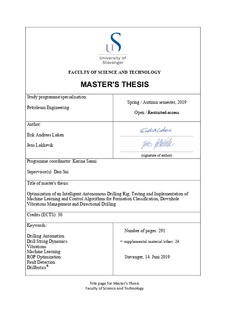| dc.description.abstract | In recent years, considerable resources have been invested to explore applications for- and to exploit the vast amount of data that gets collected during exploration, drilling and production of oil and gas. Such data will potentially become a game changer for the industry in terms of reduced costs through improved operational efficiency and fewer accidents, improved HSE through strengthened situational awareness, ensured optimal placement of wells, less wear on equipment and so on. While machine learning algorithms have been around for decades, it is only in the last five to ten years that increased computational power along with heavily digitalized control- and monitoring systems have been made available. Considering the state of art technology that exists today and the significant resources that are being invested into the technology of tomorrow, the idea of intelligent and fully automated machinery on the drill floor that is capable of consistently selecting the best decisions or predictions based on the information available and providing the driller and operator with such recommendations, becomes closer to a reality every day.
This thesis is the result of research carried out on the topic of drilling automation. Its basis has been improvements and upgrades conducted on a laboratory-scale drilling rig developed at the University of Stavanger, as part of the multi-disciplinary project; UiS Drillbotics. Main contribution of the thesis is a study on how machine learning can be used to develop models that are capable of accurately predicting what rock formation is being drilled using an autonomous control system, along with detecting some common drilling incidents in real-time on the laboratory rig. Methodology is also applied to field data from the Volve field. Furthermore, research and implementation of search algorithms to ensure optimal drilling speed (ROP), safety to personnel and environment (HSE), and efficiency along with a digitalized drilling program for directional drilling, gets presented. Finally, rig upgrades for directional drilling and research into downhole sensors that get used in a closed-loop steering model is elaborated on. | nb_NO |
